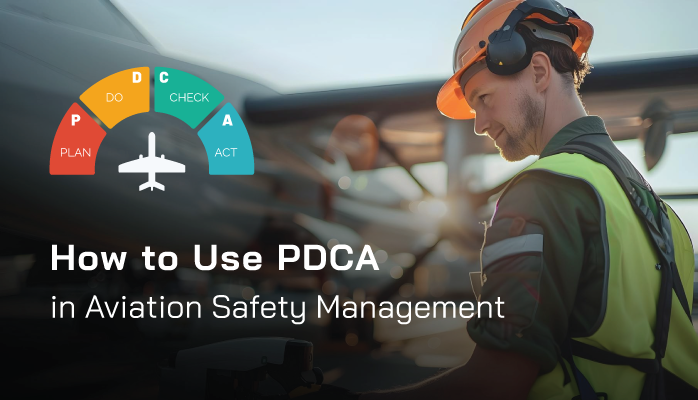What Is Plan Do Check Act (PDCA)

Plan Do Check Act is a simple but effective process to use when implementing risk controls through corrective-preventative actions. The PDCA process is initiated after you discover some deficiency/weakness in your SMS that poses an unacceptable level of safety, such as after an aviation SMS audit, reported safety concern, or trend analysis.
The things to keep in mind about PDCA are:
- It is a linear process, with a start and finish;
- It is repeatable and can be used with each identified weakness; and
- The goal is to improve your SMS with logical steps.
The acronym PDCA represents the following:
- Plan: define what the weakness is, including root causes, and identify how to fix these root causes;
- Do: implement the changes that will improve your SMS through assigning corrective preventative actions (CPA);
- Check: review the changes to see that they actually correct the weakness as intended; and
- Act: make the changes “official” in the organization by updating your operational risk profile.
PDCA is a primary process for driving continuous improvement of your SMS.
What Is the Plan Phase of PDCA
The first phase of PDCA is planning. Safety managers and/or subject matter experts are responsible for this phase, which involves:
- Identifying a weakness (discovery);
- Understanding the root causes of this weakness;
- Identifying how you can fix this weakness by addressing the root causes; and
- Creating a roadmap for fixing the weakness.
The tools safety managers and/or department heads can use to help with the Planning phase are:
Once you have identified the weakness and understand the root causes, you need to outline how you fix the weakness with corrective actions. At a minimum, this “plan” should be a short paragraph that includes:
- What the corrective action is;
- The steps that will be taken to fulfill the CPA; and
- Who will be responsible for carrying out the CPA – i.e., who is assigned the CPA.
What Is the Do Phase of PDCA

“Do” is the second step in the PDCA process. This is part of the process where the CPA assignee will carry out the actions to fix the problem. This phase simply includes:
- The subject matter expert who created, assigned, and is responsible for reviewing performance; and
- The person who was assigned the CPA and is responsible for carrying out the CPA tasks.
As far as actual responsibility in the Do phase of PDCA, the person assigned the CPA is responsible for “doing” it. In complex environments or with complex CPAs, it’s a good idea to perform a safety case on the change and ensure that it is likely to actually fix the problem.
What Is the Check Phase of PDCA
The third phase of PDCA is Check, where the subject matter expert who assigned the CPA is responsible for checking to make sure that the CPA's performance satisfies intent.
Once the assignee finishes CPA tasks, there are two outcomes:
- Assignee performance satisfies the intent of the CPA; or
- Assignee performance does NOT satisfy the intent of the CPA.
Performance can be deficient because the assignee was lax in their duties, in which case you will need to ensure that they repeat the tasks. Performance can also be deficient because the CPA was not planned well (or is the wrong CPA), in which case you should update your CPA with better tasks or create a new CPA that better fixed the weakness.
A good practice here is to document a performance rating that will be helpful for future review.
Related Aviation Safety Manager Articles
- How Aviation Safety Managers Can Deal With Silo Mentality
- Executive Manager Role in Safety Management Systems
- 5 Habits of Highly Effective Aviation Safety Managers
What Is the Act Phase of PDCA
Act is the last phase of PDCA and is the responsibility of the Safety Manager to update the System with any changes to the system. In this case, “updating the system” likely means updating your operational risk profile documentation to account for:
- Any risk controls; or
- Changes to existing processes, policies, and so on.
Also, you should also strongly consider:
- Communicating any changes to your organization’s stakeholders; and
- Ensuring that any changes are incorporated into your SMS review process.
For more information see our article on monitoring the effectiveness of risk controls.
Last updated in January 2026.





